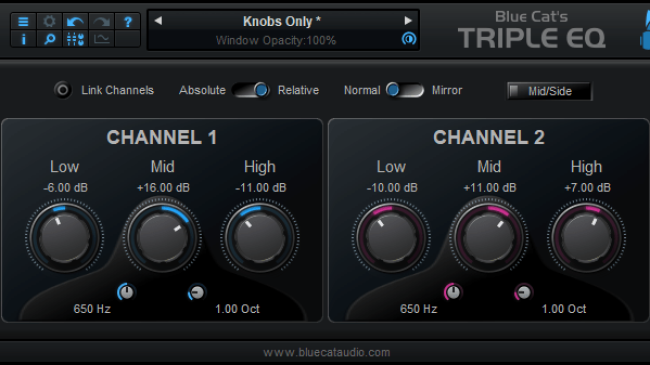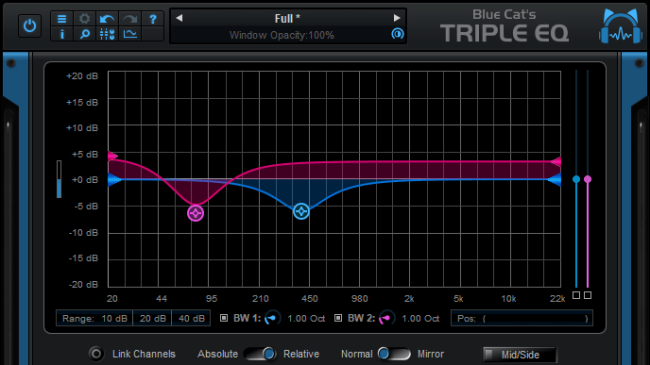Table Of Content
Introduction
Blue Cat's Triple EQ is a free 3 bands semi-parametric equalizer that can be controlled like a single filter, with a customizable shape.
This free EQ includes a low shelf filter, a high shelf filter and a boost/cut peak filter. Its wide range of gain (+/-40 dB per band) and bandwidth (.01 to 5 Octave) makes it very versatile to create any filter shape. The three filters are linked together so that when you change the center frequency or the bandwidth, the parameters of the three filters are modified accordingly: you can control the entire equalizer characteristics with a single mouse click.
The graph shows the computed frequency response of the plug-in, so that you can exactly know how your signal is processed. The controls are directly available on top of the filter graph, making the design of the filter shape even easier.
The plug-in also offers a dual channels version, with independent left/right or mid/side equalization capabilities. Both channels can be linked together in many ways, letting you transform this plugin into a frequency-dependent panner and much more.
The plug-in can be controlled in real time with MIDI or automation: it is capable of absolutely zipper-free clean and continuous time-varying equalization with no latency. it is the ideal companion of our audio analysis tools for signal-dependent side chain filtering.
Want more bands? Check out Blue Cat's Parametr'EQ series.
System Requirements
MacOS
- An Intel or Apple Silicon processor.
- Mac OS 10.9 or newer.
- Any VST / Audio Unit / AAX compatible application (64-bit) .
Windows
- An SSE2-enabled processor (Pentium 4 or newer).
- Microsoft Windows Vista, Windows 7, 8, 10 or 11.
- Any VST / AAX compatible host software (32 or 64 bit).
For more information about supported platforms, see our Knowledge Base.
Installation
The plug-ins versions cannot be run standalone: they require a host application (see the System Requirements chapter for more information). Depending on which host application you use, you might need to install the plug-ins in different locations.
Before installing one of the plug-in versions, you should close all your host applications.
Windows
Install
All versions of the plug-in provide an installation program. Follow the steps of the wizard to install the software on your machine. During the installation you will be asked where you want the software to be installed. For the VST version, you should install the plug-in inside the VST plug-ins folder used by your host application(s). The default path set in the installer should work for most applications, but you should check your host software documentation to know where it looks for VST plug-ins. For other plug-in types, you should just use the standard path.
Some applications will not automatically rescan the new plug-ins, so you might have to force a refresh of the plug-ins list.
Upgrade
When a new version of the software is released, just launch the new installer: it will update the current installation.
Uninstall
To uninstall the software, simply launch the "Uninstall" program that is available in the start menu or in the configuration panel. It will take care of removing all files from your computer.
Mac
Install
On Mac the plug-ins are available as drive images with an installer. After download, double click on the dmg file to open it. You can then double click on the installer (.pkg file) to install the package.
Note for Mac OS 10.15 Catalina or newer: you may have to right click on the installer and select "Open" instead of double clicking on the file to launch the installation if your computer is not connected to the Internet.
Upgrade
When a new version of the software is released, just launch the new installer: it will update the current installation.
Uninstall
To uninstall the software, simply remove the component(s) from their install location (move them to the trash):
- AAX plug-ins are installed in the /Library/Application Support/Avid/Audio/Plug-Ins/ folder
- Audio Units (AU) are installed in the /Library/Audio/Plug-Ins/Components/ folder
- RTAS Plug-ins are installed in the /Library/Application Support/Digidesign/Plug-Ins/ folder
- VST plug-ins are installed in the /Library/Audio/Plug-Ins/VST folder
- VST3 plug-ins are installed in the /Library/Audio/Plug-Ins/VST3 folder
If you want to completely remove all settings and configuration files, you can also remove these additional directories that may have been created on your computer:
- ~/Library/Preferences/Blue Cat Audio/[Plug-in name and TYPE], where TYPE is VST, AU, RTAS or AAX: global preferences.
- ~/Documents/Blue Cat Audio/[Plug-in name]: user data, such as presets, additional skins and user-created plug-in data.
Please be aware that these directories may contain user data that you have created. Remove these directories only if you do not want to reuse this data later.
First Launch
Blue Cat Audio plug-ins cannot be run standalone, they require a host application (see the System Requirements chapter for more information). Some host applications will require you to scan the plug-ins before they are available in the application.
If the plug-in is not available in the application, please check that it has been installed in the appropriate directory (with no host application running), and that the host application has scanned it.
Using Blue Cat's Triple EQ
The User Interface
Note: The main toolbar, menus and basic features available with all our plug-ins are detailed in the Blue Cat Audio Plug-ins Basics section.
Blue Cat's Triple EQ effect comes in two flavors: single or dual channels. The single channel version offers the same controls as the dual channels, but for a single channel only. So we'll cover the dual channels version in this manual.
The Graph View
By default, the user interface shows a frequency response graph with integrated controls. It is possible to also show knobs to control the main parameters as explained later.
The blue color is used to reference the left o mid channel, and the pink color is used for the right or side channel.

Show/Hide the knobs view (see below) and/or graph view.
Control the gain of the low frequencies (bass).
Control the gain and frequency of the mid frequencies filter. The bandwidth can also be changed with the mouse wheel or by double clicking on each cat paw.
Control the gain of the high frequencies (treble).
Control the overall gain (offsets the whole frequency response).
Auto gain mode: when auto gain mode is on, the overall gain of the plugin is automatically adjusted according to the maximum filter gain to keep the maximum frequency response around 0dB.
The position of the mouse cursor is shown here to help you adjust the values of the filters frequencies and gains.
Adjust the bandwidth of the mid filter (auto adjusts the cutoff frequencies of the high and low shelf filters).
Show/Hide controls for a channel on the graph.
Choose the range of the graph and controls: you can zoom to your prefered value by clicking on the controls below the graph or by dragging the slider on the left.
Link channels: when the link is on, moving the control for a channel automatically adjusts the controls for the other channel, according to the options set.
Absolute/Relative: in absolute mode the values of the controls for both channels are identical, whereas in relative mode only controls variations are reported on the other channel (letting you setup a different EQ on each channel and then apply linked modifications for example).
Mirror mode: in mirror mode, the gain value for both channels are reversed. It is very handy when you want to use the EQ as a balance between channels.
Select Left/Right or Mid/Side mode. In Mid/Side mode, the controls in blue color affect the mid (center, or mono) channel, and the red controls affect the sides (non-mono) signal.
The Knobs View
Below is a screenshot of the plug-in with the knobs view (graph hidden). The knobs let you control the same parameters as the ones available in the graph view.
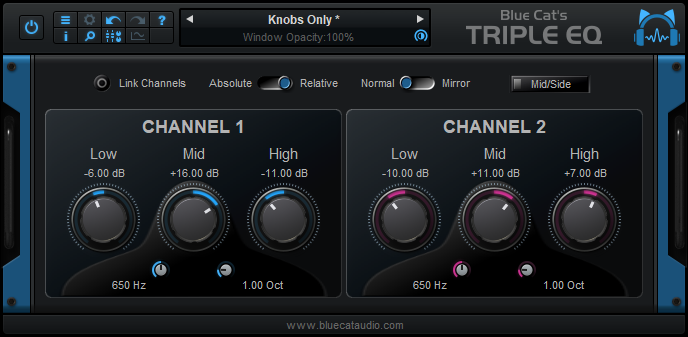
This view also lets you access the midi and automation settings for most of the parameters of the plug-in (see the next chapter for details).
The various elements of the user interface (knobs, sliders, buttons...) are simple and intuitive to operate, but more information about how to interact with them is available in the "Plug-ins Basics" chapter of this manual.
Operation
Using the Blue Cat's Triple EQ plug-in is straightforward: draw your EQ curve for each channel (left/right, mid/side or single channel) using the controls and you are done! Here are however a few tricks to help you get the best out of this particular EQ.
Dual channels
With the dual version and no link between channels, you can use the plugin to shape the spectrum of the left and right or center and sides of a stereo track independently. You can for example choose to reinforce bass on the center of a mix, and boost the highs on the sides to make it feel wider without yet making it too artifical.
Single Channel
With the single channel version, or when the link is enabled and its mode set to "absolute", the plugin behaves just like a single channel EQ: both channels are processed with the exact same settings.
Multi Bands Widener/Narrower
In Mid/Side mode, with the link enabled in absolute mode, and if you use the "Mirror" function, the plug-in will behave as a multiple bands widening/narrowing balance. In this case you can choose to mask the side band controls and only use the mid controls. Pushing the cursor up will push the sound to the mid channel (narrowing the sound), whereas moving down will widen the stereo signal.
Multi Bands Balance
You can use the same technique in stereo mode (mid/side disabled) to usethe plug-in as a spectral Left/Right balance.
Need more Bands?
If you need more bands you can use several instances of the plug-in in series. You will then be able to control more frequency bands at a time!
Use Automation
Since this plug-in supports smooth parameters update, you can use and abuse of automation to create time varying filter effects. It is also possible to control these variations remotely in real time thanks to the ability of the plugin to be controlled via MIDI, as shown in our MIDI Wah tutorials (see the tutorials section).
Blue Cat Audio Plug-Ins Basics
This chapter describes the basic features that are common to all our plug-ins. If you are already familiar with our products, you can skip this part.
User Interface Basics
About Skins
Like all Blue Cat Audio plug-ins, Blue Cat's Triple EQ uses a skinnable user interface. It means that the appearance and behavior of the user interface can be entirely customized.
Especially with third party skins, the experience may be quite different from the one offered by the default skins that we provide. However, our plug-ins and our skinning engine have several standard features that will be available whatever your favorite skin.
More information about custom skins can be found in the skins section.
The Main Toolbar
In most skins, an optional toolbar at the top of the user interface gives you access to the main options and settings of the plug-in:

Smooth Bypass
On the left, the power button can be used to smoothly bypass the plug-in.
Presets Area
At the center of the toolbar, you can see the current preset area (the "Default Settings" box). It displays the name of the current preset, with a "*" at the end if it has been modified since loaded.
The arrows on the left and right let you navigate thru the (factory and user) presets available for the plug-in.
Clicking on the preset name opens the presets menu which lets you manage the presets of the plug-in.
Using the knob on the bottom right of this area, you can reduce the opacity of the window, and make it transparent (the actual result may depend on the host application). Additional messages may appear in the area next to this knob, depending on the plug-in.
Some plug-ins may also propose you to manually select the audio I/O inside the plug-in (bottom left of the presets area), regardless of the host configuration. It can be useful for example to save CPU by selecting mono to stereo configurations (instead of full stereo sometimes chosen by default by the host), or add extra channels to manage side chain internally, when the host does not provides any side chain input. Please note that this does not change the number of I/O seen by the host application.
Commands
The icons in the toolbar give you access the to the following commands that are detailed in the next paragraph:
| Icon | Name | Function |
|---|---|---|
|
|
Menu | Open the main menu |
|
|
Control Settings | Display the controls settings menu (to manage automation and MIDI control, as described here). |
|
|
Undo | Undo |
|
|
Redo | Redo |
|
|
Manual | User Manual |
|
|
About | About |
|
|
Zoom | Scale the user interface (from 70% to 200%). |
The Main Menu
The main menu is available from the main toolbar, or if you right click anywhere on the background of the plug-in:
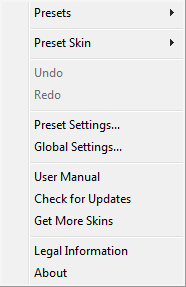
- Presets: opens the presets menu to manage presets.
- Preset Skin: opens the skins menu to choose the skin for the current preset and manage alternative skins for the software.
- Undo/Redo: undo or redo the latest modifications. This includes all changes made to the current preset settings such as MIDI or automation preferences.
- Presets Settings: open the presets settings window. It lets you change the skin, MIDI and automation settings for the current preset.
- Global Settings: open the global settings window. It lets you change the skin, MIDI and automation settings that are used by default in all instances of the plug-in (if not overridden by the current preset).
- User Manual: open this user manual.
- Check for Updates: opens up our website to let you check if any update for this software is available.
- Get More Skins: get more skins for this software.
- Legal Information: browse licensing and misc legal documents.
- About: displays the “about” dialog box.
Controls
Examples
Here are a few examples of typical controls you will encounter in the user interface of our plug-ins:
| slider | slider | knob | button | Text control |
|
|
 |
 |
|
|
Interacting with Controls
You can interact with the controls of the plug-in interface either with the mouse or the keyboard.
Setting the keyboard focus on a control (so that it responds to key strokes) may be automatic (when you pass the mouse over it it gets focus) or manual (you have to click on the control to set the focus on it). Note that all host applications behave differently regarding keyboard handling. In some applications you may not be able to use all keys described later in this manual to interact with our plug-ins. It is usually made obvious to you to know the active surfaces of the skin (the places where you can click with the mouse): the mouse cursor usually changes when you can do something on a control. In the default skins delivered with the plug-in, the cursor changes to a small hand or an arrow to tell you when your mouse is over an active control.
Mouse
Various mouse movements will let you interact with the controls:
| Mouse Interaction | Action |
|---|---|
| Left Click | Acquire focus and start dragging or push (button) |
| Left Click + Alt Key | Set the value to default |
| Left Double Click |
Acquire focus and launch the “fine
tuning” edit box (except button):
 |
| Right Click | Set the value to default |
| Mouse Wheel | Increment or decrement the position (focus required) |
| Mouse Drag | Change the control position depending on mouse movement (except button) |
Keyboard
All control widgets support the following keys (note that some of them are caught by the host and thus never forwarded to the control. For example in Steinberg Cubase SX you cannot use the arrow keys to control the plug-in):
Keys Common to All Controls
| Key | Action |
|---|---|
| Up Arrow | Small increment of the position (up or right) |
| Down Arrow | Small increment of the position (down or left) |
| Left Arrow | Same as Down Arrow |
| Right Arrow | Same as Up Arrow |
| Page Up | Large increment of the position (up or right) |
| Page Down | Large decrement of the position (down or left) |
| + | Small increment of the value of the control |
| - | Small decrement of the value of the control |
| d | Set to default value (same as mouse right click) |
| e |
Opens the 'fine tuning' window to precisely
set the parameter:
 |
| SHIFT | When the key is down, the fine tuning mode is on, and you can modify the value with better precision when moving the mouse, the mouse wheel or using the keyboard. Just release the key to get back to the normal mode. |
Keys Specific to Buttons
| Key | Action |
|---|---|
| Enter | Pushes the button |
Presets
To get started with the plug-in and discover its capabilities, a couple of factory presets are provided. You can also save your own presets and recall them later for other projects. Our plug-ins propose a full-featured preset manager to let you save, browse, organize and recall its presets.
The Presets Menu
The presets menu can be opened from the main menu or the main toolbar. It displays the list of presets available for the plug-in as well as commands to load, save or organize presets:

- Factory Presets: shows the list of factory presets delivered with the plug-in.
- "Folder A" to "User Preset Z": user presets and categories.
- MIDI Program Change: activate MIDI Program Change support (see below).
- Load: load preset from file.
- Save: save current state to last loaded user preset.
- Save As: save current preset to a file.
- Copy copy preset to the system clipboard.
- Paste paste preset from the system clipboard, if available.
- Save As User Default: save the current state as the default preset. This preset is used every time a new instance of the plug-in is created.
- Clear User Default: reset the default preset to its factory state: this makes the plug-in forgets the custom settings you might have saved as a default preset.
More about Presets
There are two types of presets: factory presets (read only) that are provided with the plug-in, and user presets that can be created and stored by the user.
The user presets are stored in a subdirectory of the documents folders of your profile ("Documents" on Mac, and "My Documents" on Windows): Blue Cat Audio/[Plug-in Name]/Presets. Each preset is stored as an individual file. You can create folders and subfolders in the Presets directory to classify your presets, as shown in the example below:

If you save a preset named "Default" in the root Presets directory, it will override the factory default preset (that's what "Save As Default" does). To restore the factory default preset, you can just remove this file or use the "Reset Default" command.
MIDI Program Change
It is possible to load presets remotely using MIDI "Bank Select" and "Program Change" messages. To enable this feature, select a MIDI channel to receive the events from in the MIDI Program Change menu item from the presets menu:

This setting is saved for each plug-in istance with your session but not in presets (except for the default preset, using the "Save as User Default command"). Once activated, the plug-in menu will display the bank number followed by the preset number for each preset:
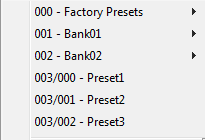
Every root folder is considered as a new bank, starting with the factory presets (bank 0). Program and bank numbers may change while you add folders and presets, so you should be careful when naming them if bank and program numbers matter to you. It is recommended to use folders to make this task simpler. As a side note, sub folders do not define additional banks (all presets contained in sub folders are associated with the current bank.
As specified by MIDI, bank select messages are not used until a program is actually selected.
MIDI Implementation note: the software supports all types of Bank Select methods. You can use either MIDI CC 0 or MIDI CC 32 to select banks. If both are used simultaneously, they are combined together so that you can use more banks (in this case CC0 is LSB and CC32 is MSB, and actual bank number is 128*CC0+CC32).
MIDI and Automation Control
Blue Cat's Triple EQ can also be remotely controlled via MIDI using MIDI CC ("Control Change") messages or automation curves, if your host application supports it. It is possible to customize the channel, control numbers, range and response curve used for each parameter in the settings panel available from the main menu (see the Plug-in Settings chapter for more details).
MIDI and Automation Settings Menu
The main menu
Most skins also provide the ability to change MIDI and automation settings directly in the main user interface. Clicking on the control settings icon in the main toolbar opens the following menu:
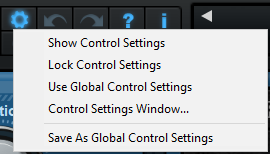
- Show Control Settings: show direct access to individual control settings for each parameter in the user interface (see next paragraph).
- Lock Control Settings: lock the current controls settings for MIDI and automation so that they remain unchanged when loading presets.
- Use Global Control Settings: ignore the current MIDI/automation settings and use the global settings instead.
- Control Settings Window: display the control settings window, to change control settings for all parameters.
- Save As Global Control Settings: save the current settings as global settings (used by default, when no specific MIDI/Automation setting has been set for the cuirrent preset).
Individual Control Settings
When this feature is activated using the "Show Control Settings" item in the MIDI and Automation Settings menu, dropdown menu buttons appears next to the main controls displayed by the plug-in:
Clicking on this button shows the MIDI/Automation settings menu:
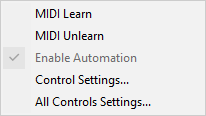
- MIDI Learn: launches MIDI learn mode for the control: touch your MIDI controller and the control will learn from it the MIDI channel and CC number. To end the learn mode, reopen this menu and deselect the option.
- MIDI Unlearn: deactivates MIDI control for this parameter.
- Control Settings: launches the advanced settings panel described below. This controls the settings for the current preset.
- All Control Settings: display the control settings window, with access to all parameters.
Advanced MIDI and Automation Settings
You can completely customize the way the plug-in is controlled by automation and MIDI. For a global view of all parameters at a time, you can use the Plug-in Settings window for the current preset which is available from the main menu.

MIDI Settings:
- Enable MIDI: enable/disable the MIDI control of the parameter.
- Channel: MIDI Channel for the parameter control. If set to 0, the plug-ins will accept Control Change Messages from all MIDI Channels (MIDI Omni mode).
- CC: Control Change Number.
- Learn: click on this button to activate the MIDI learn functionality. When it is activated, you can move your MIDI controller, and the plug-in will automatically set the MIDI Channel and CC Number.
MIDI and automation settings:
- Response: response curve of the MIDI or automation control: from very fast to slow control.
- Min: minimal value of the parameter when MIDI controlled or automated.
- Max: Maximum value of the parameter when MIDI controlled or automated.
Note: if the Min value is higher than the Max value, the response curve will be reversed: increasing the control value will decrease the parameter value.
Note: if you double click on the parameter text control boxes for the max and min values, a “fine tuning” edit box will appear and let you change the min and max values with more precision:

More
Check our online tutorial for more screenshots and more examples of our plug-ins user interfaces.
Blue Cat's Triple EQ Parameters
All parameters described below can be automated and controlled via MIDI if your host application supports it. You can precisely define this behavior in the settings panels described later in this manual.
Single Channel version
|
id |
Name |
Unit |
Description |
|---|---|---|---|
|
dsp.input0 |
Bypass |
|
Bypass the effect. |
|
dsp.input1 |
Gain |
dB |
Main gain. |
|
dsp.input2 |
Frequency |
Hz |
Center frequency of the mid band filter. This also adjusts the cutoff frequencies of the low and high shelf filters automatically. |
|
dsp.input3 |
Bandwidth |
Octave |
Bandwidth of the mid band filter. This also adjusts the cutoff frequencies of the low and high shelf filters automatically. |
|
dsp.input4 |
Low |
dB |
Gain of the low shelf filter. |
|
dsp.input5 |
Mid |
dB |
Gain of mid band filter. |
|
dsp.input6 |
High |
dB |
Gain of the high shelf filter. |
Dual Channels version
|
id |
Name |
Unit |
Description |
|---|---|---|---|
|
dsp.input0 |
Bypass |
|
Bypass the effect. |
|
dsp.input1 |
Stereo Mode |
|
Left/Right or Mid/Side operation mode. |
|
dsp.input2 |
Gain (1) |
dB |
Main gain of the first channel. |
|
dsp.input3 |
Frequency (1) |
Hz |
Center frequency of the mid band filter for the first channel. This also adjusts the cutoff frequencies of the low and high shelf filters automatically. |
|
dsp.input4 |
Bandwidth (1) |
Octave |
Bandwidth of the mid band filter for the first channel. This also adjusts the cutoff frequencies of the low and high shelf filters automatically. |
|
dsp.input5 |
Low (1) |
dB |
Gain of the low shelf filter for the first channel. |
|
dsp.input6 |
Mid (1) |
dB |
Gain of the mid band filter for the first channel. |
|
dsp.input7 |
High (1) |
dB |
Gain of the high shelf filter for the first channel. |
|
dsp.input8 |
Gain (2) |
dB |
Main gain of the second channel channel. |
|
dsp.input9 |
Frequency (2) |
Hz |
Center frequency of the mid band filter for the second channel. This also adjusts the cutoff frequencies of the low and high shelf filters automatically. |
|
dsp.input10 |
Bandwidth (2) |
Octave |
Bandwidth of the mid band filter for the second channel. This also adjusts the cutoff frequencies of the low and high shelf filters automatically. |
|
dsp.input11 |
Low (2) |
dB |
Gain of the low shelf filter for the second channel. |
|
dsp.input12 |
Mid (2) |
dB |
Gain of the mid band filter for the second channel. |
|
dsp.input13 |
High (2) |
dB |
Gain of the high shelf filter for the second channel. |
Blue Cat's Triple EQ Curves
The Triple EQ plug-in also provides visual feedback about the response curve of the equalizer with output curves.
Single Channel Version
|
id |
Name |
Description |
|---|---|---|
|
dsp.output_curve0 |
Frequency Response |
Global frequency response of the equalizer. |
|
dsp.output_curve1 |
Frequency Response (dB) |
Global frequency response of the equalizer (decibels). |
|
dsp.output_curve2 |
Low Frequency Response (dB) |
Frequency response of the low pass filter. |
|
dsp.output_curve3 |
Mid Frequency Response (dB) |
Frequency response of the mid band filter. |
|
dsp.output_curve4 |
High Frequency Response (dB) |
Frequency response of the high pass filter. |
Dual Channels Version
|
id |
Name |
Description |
|---|---|---|
|
dsp.output_curve0 |
Frequency Response (1) |
Global frequency response of the equalizer for the first channel. |
|
dsp.output_curve1 |
Frequency Response (dB) (1) |
Global frequency response of the equalizer (decibels) for the first channel |
|
dsp.output_curve2 |
Low Frequency Response (dB) (1) |
Frequency response of the low pass filter for the first channel. |
|
dsp.output_curve3 |
Mid Frequency Response (dB) (1) |
Frequency response of the mid band filter for the first channel. |
|
dsp.output_curve4 |
High Frequency Response (dB) (1) |
Frequency response of the high pass filter for the first channel. |
|
dsp.output_curve6 |
Frequency Response (2) |
Global frequency response of the equalizer for the second channel. |
|
dsp.output_curve7 |
Frequency Response (dB) (2) |
Global frequency response of the equalizer (decibels) for the second channel |
|
dsp.output_curve8 |
Low Frequency Response (dB) (2) |
Frequency response of the low pass filter for the second channel. |
|
dsp.output_curve9 |
Mid Frequency Response (dB) (2) |
Frequency response of the mid band filter for the second channel. |
|
dsp.output_curve10 |
High Frequency Response (dB) (2) |
Frequency response of the high pass filter for the second channel. |
Plug-in Settings
In addition to the controls offered in the main user interface, Blue Cat's Triple EQ has various settings that let you fine tune the behavior of the plug-in. You can choose to change these settings either for the current preset or globally for all instances of the plug-in.
The Global Settings Window
The settings available in this window apply to all instances of the plug-in, for all presets, if not overridden in the presets settings. Consider these settings as “default” settings.
General
You can change the default skin for all instances of the plug-in: write the skin file path in the text edit box or click on the button to open a file chooser dialog. If you have several instances of the plug-in opened in your session, you will have to re-open the user interfaces of these plug-ins to see the skin change.
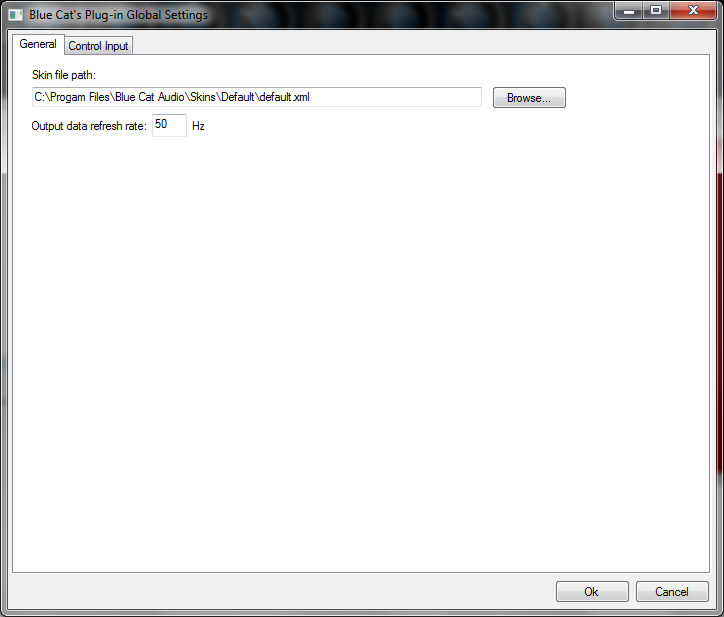
The output data refresh rate can also be customized for all instances of the plug-in. It controls the refresh rate of non-audio data produced by the plug-in (parameters, curves...). It also controls the refresh rate of output MIDI CC messages or output automation data. The higher the refresh rate, the better precision, but also the higher cpu usage (some host applications may also have trouble recording MIDI data at high refresh rates). The default value is 50 Hz.
Global Control Input Settings (MIDI and Automation)
The plug-in offers a couple of settings that affect the way it is controlled by MIDI messages or automation. While the first settings only apply to MIDI control, the "Control Response", "Min" and "Max" settings apply to both automation and MIDI control.
For each parameter you can define a default MIDI channel and CC number. You can then control the plug-in with an external MIDI controller or one of our plug-ins that generate MIDI messages.
The settings below are available for each plug-in parameter.
MIDI Settings:
- Enable MIDI: enable/disable the MIDI control of the parameter.
- Channel: MIDI Channel for the parameter control. If set to 0, the plug-ins will accept Control Change Messages from all MIDI Channels (MIDI Omni mode).
- CC: Control Change Number.
- Learn: click on this button to activate the MIDI learn functionality. When it is activated, you can move your MIDI controller, and the plug-in will automatically set the MIDI Channel and CC Number.
MIDI and automation settings:
- Response: response curve of the MIDI or automation control: from very fast to slow control.
- Min: minimal value of the parameter when MIDI controlled or automated.
- Max: Maximum value of the parameter when MIDI controlled or automated.
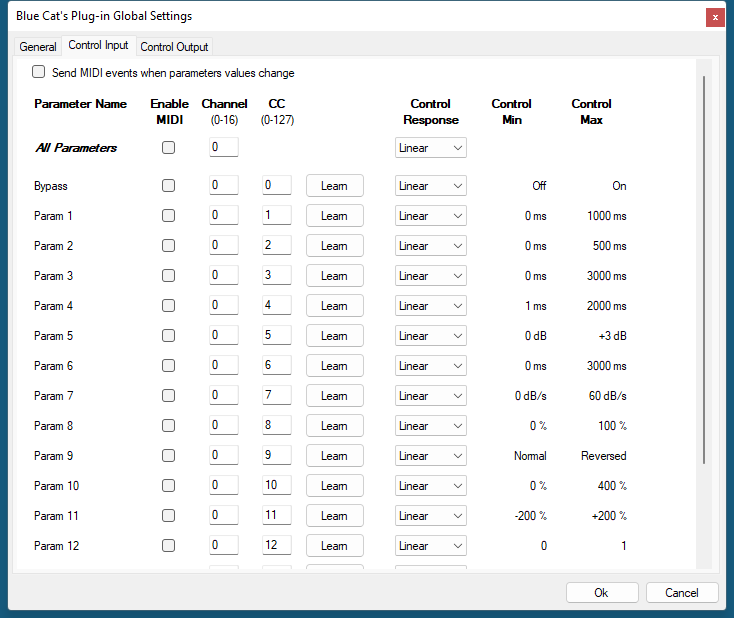
Note: if the Min value is higher than the Max value, the response curve will be reversed: increasing the control value will decrease the parameter value.
Note: if you double click on the parameter text control boxes for the max and min values, a “fine tuning” edit box will appear and let you change the min and max values with more precision:

"Send MIDI events when parameters values change": activate this option when using a control surface that accepts MIDI events as input. MIDI messages will be sent to the output of the plug-in when the user change the parameters values in the user interface, to keep the software and the controller in sync. MIDI is only sent for parameters that are activated for MIDI control.
The Current Preset Settings Window
In this window you can change the settings for the current preset of the current instance of the plug-in only.
Preset Skin
You can choose to use the global skin setting or to change the skin for the current preset. This way you can have different skins for different instances of the plug-in in the same session in order to differentiate them.
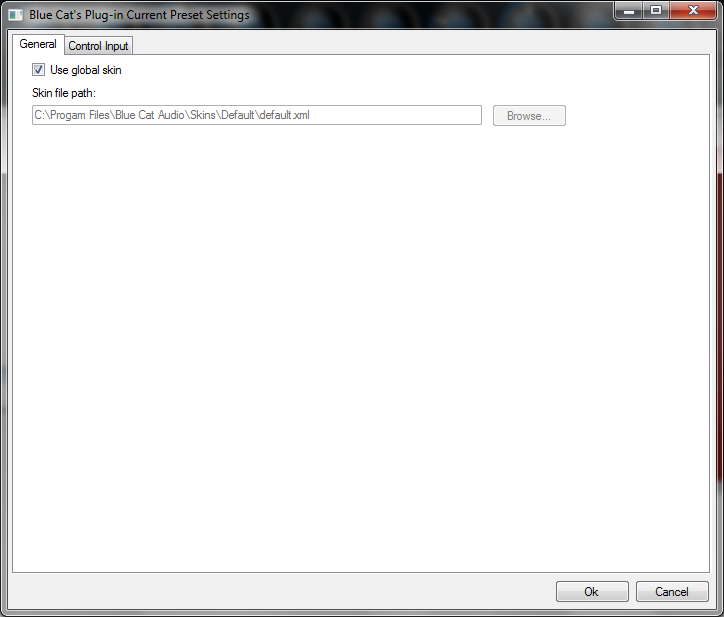
Preset Control Input Settings (MIDI and Automation)
Use the global settings or override them for the current preset. The parameters are the same as for the global input settings.
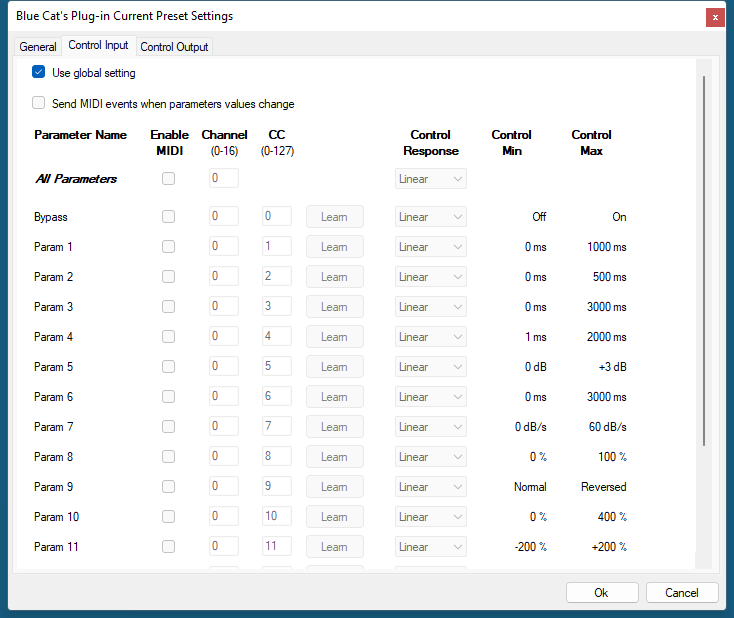
About Skins
Blue Cat's Triple EQ integrates Blue Cat's skinning engine that allows you to customize the user interface. You can download alternate skins for your plug-in at the following address:
If you don't find a skin that fits your need or if you want a custom one, you can choose to create your own skin.
Choosing the Skin
There are two ways to select the skin of your plug-in: you can change the default (or 'global') skin, or change the skin for the current preset only (either in the preset settings page or from the main menu). The global skin applies to all plug-in instances (choose this one if you want to use the skin used by default, regardless of the session or preset), whereas the current preset skin only applies to the current preset of the current plug-in instance (use this one if you want to change only the skin for the current session/preset).
Note: in some host applications, the plug-in window won't resize automatically when you choose a skin with a different size. In this case, just close the window and re-open it: it will be displayed with the right size.
The Skins Menu
The skins menu can be opened from the main menu. It displays the list of skins available for the plug-in as well as commands to manage the skin used by default when no preset skin has been selected:

- First Section - Factory Skins: shows the list of factory skins delivered with the plug-in ("Default" and "Light" in this example).
- Second Section - User Skins: shows the list of user skins that have been installed in the Documents Skins folder for the plug-in (see below).
- Use Global Skin: use the global skin for the current preset/session (unloads any custom skin previously selected for the current preset).
- Load: opens a file browser dialog to manually select the skin from the file system.
- Save As Global Skin: use the current preset skin as the global skin (loaded by default if no preset skin has been defined).
Installing User Skins
To select user skins directly from the skins menu, install them in the "Skins" directory available in the plug-in's documents folder:
[Your Documents Folder]/Blue Cat Audio/[Plugin Name]/Skins/
The skin engine will scan this folder for new skins (xml files) and display them in the menu. The skin files should be in the root skins folder or in a subdirectory inside this folder: subdirectories are not scanned recursively.
Other Methods to Select Skins
You can also select the skins in the settings panels available from the main menu:
The global skin (used by default if no preset skin has been selected) can be changed in the global settings pane. The current preset skin can be changed in the preset settings page .
Create a Custom Skin
You can create custom skins for your plug-in in order to adapt it to your exact needs. You can change its look and feel and make it completely integrated in your virtual studio!
Just read the Blue Cat's Skinning Language manual and download the samples for the tutorial on http://www.bluecataudio.com/Skins. You can get ready to create your own skins in a few minutes. You can then share your skins on our website.
More...
This manual only covers the main aspects of Blue Cat's Triple EQ. Our website offers many additional resources for your Blue Cat's Triple EQ plug-in. It is constantly updated, so keep an eye on it!
Updates
As you can see in the history log below, we care about constantly updating our products in order to give you the latest technology available. Please visit our website often to check if Blue Cat's Triple EQ has been updated, or subscribe to our Newsletter to be informed of the latest news about our products.
You can also follow us on twitter, facebook and instagram for almost real time updates notification, and subscribe to our YouTube channel to watch the latest videos about our software.
Versions History
V4.5 (2024/09/09) |
|
V4.45 (2024/02/15) |
|
V4.44 (2022/12/12) |
|
V4.43 (2022/09/06) |
|
V4.42 (2022/09/02) |
|
V4.41 (2022/02/10) |
|
V4.4 (2022/01/03) |
|
V4.32 (2020/12/15) |
|
V4.31 (2019/12/20) |
|
V4.3 (2018/12/13) |
Warning: because of a bug of the initial VST3 release, this new version may not work with existing sessions that used the VST3 format. See this blog post for more details and how to fix it. |
V4.2 (2016/03/03) |
|
V4.1 (2014/01/09) |
New Features:
|
V4.02 (2013/06/21) |
New Features:
|
V4.01 (2012/04/23) |
Bug Fixes:
|
V4.0 (2012/03/28) |
New Features:
|
V3.53 (2011/02/10) |
|
V3.52 (2010/03/19) |
This update only concerns the RTAS version of the plug-in:
|
V3.51 (2010/02/25) |
|
V3.5 (2010/01/30) |
|
V3.4 (2009/11/20) |
|
V3.3 (2009/09/21) |
|
V3.21 (2009/05/05) |
Mac VST update: fixed incompatibility issues with Cubase 5 on Mac. |
V3.2 (2009/02/03) |
Mac Audio Unit Support. |
V3.2 (2008/11/21) |
|
V3.1 (2008/05/06) |
|
V3.0 (2008/04/14) |
|
V2.1 (2006/11/29) |
|
V2.0 (2006/09/27) |
|
V1.0 (2006/06/06) |
First release. |
Thanks again for choosing our software!

See you soon on www.bluecataudio.com!











